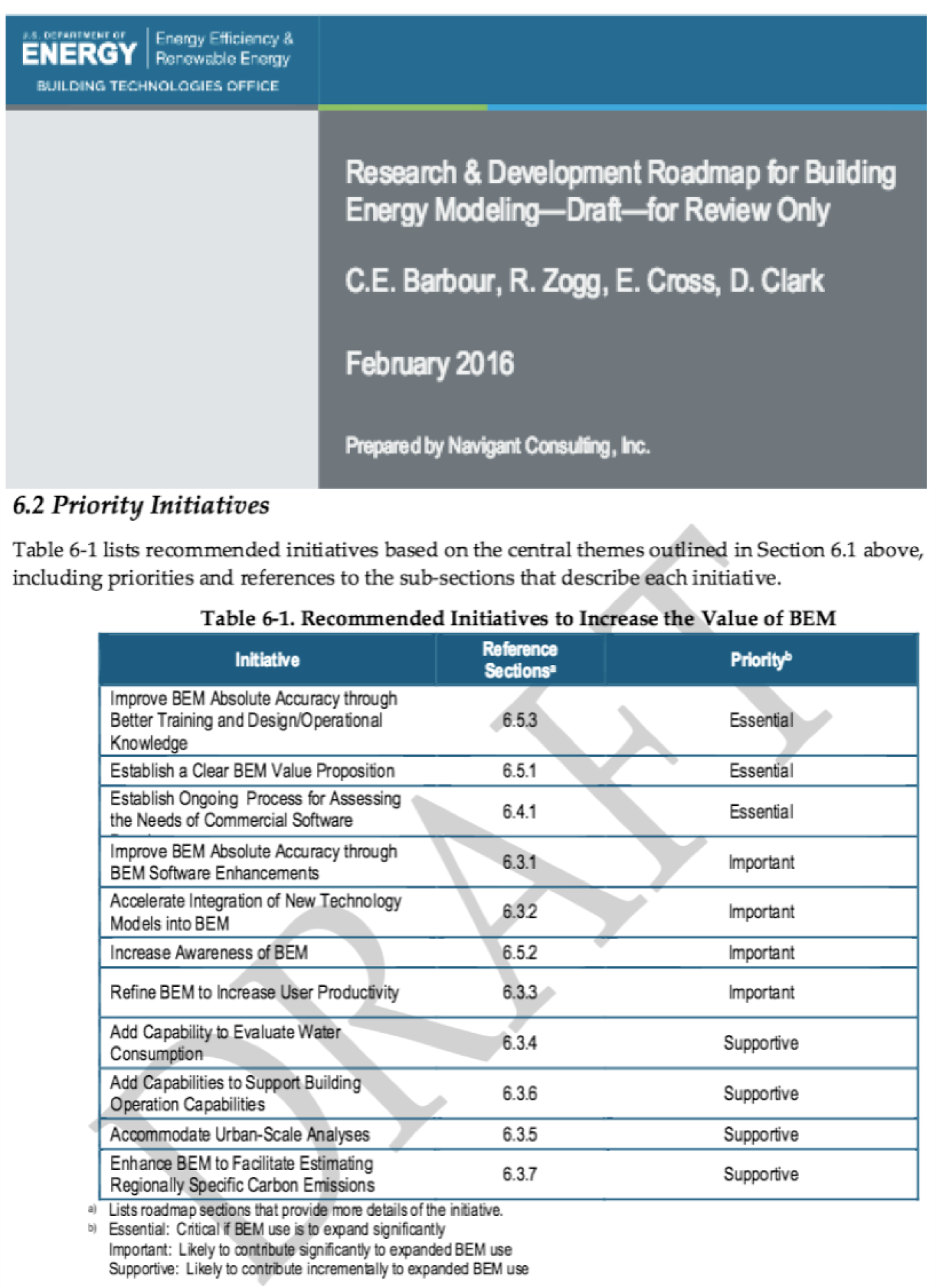This week, BTO published two important and related documents regarding its Building Energy Modeling (BEM) program.
February 10, 2016
Selections from the front page of the BEM R&D roadmap draft and the recommended initiatives table.
This week, BTO published two important and related documents regarding its Building Energy Modeling (BEM) program. The first is the final revision of the BTO multi-year program plan (MYPP). The MYPP is a BTO-level document developed with stakeholder feedback, but largely by BTO staff. The MYPP outlines BTO’s strategic direction for the next five fiscal years, FY2016 through FY2020. The MYPP sets energy savings targets for the building sector, translates those targets into performance, cost, and adoption targets for individual technologies (including BEM), and outlines strategies and planned projects for achieving these targets.
The MYPP addresses BEM in Section 2.5, starting on page 109. Highlights of the MYPP include BTO’s targets for BEM adoption, including the use of BEM in the design of 50% of new commercial building square footage by 2020 and 90% by 2030 as well as preliminary use of BEM in building operations by 2020 and 20% commercial square footage coverage by 2030. The strategies outlined by the MYPP focus on characterizing the accuracy of BEM engines and improving accuracy as necessary, continuous improvement of open-source tools such as EnergyPlus and OpenStudio, and expanding partnerships with industry and professional organizations to provide software, services, and support to the BEM community.
In conjunction with the MYPP, BTO also published a set of program logic models that trace BTO activities to outputs and market outcomes. The BEM logic model is a useful and colorful one-slide digest of BTO’s BEM sub-program.
The second document is the draft Research & Development Roadmap for BEM. Unlike the MYPP, the Roadmap is specific to BEM and was developed by Navigant Consulting via a comprehensive stakeholder process that included BTO, the national labs, BEM practitioners, software vendors, researchers, and educators. The R&D Roadmap references the MYPP adoption targets and takes a deeper look at technology and market barriers that stand in the way of meeting those targets, and recommends solutions and approaches.
The most important aspect of R&D Roadmap is that it provides a snapshot of stakeholder views of the BEM industry in general and of BTO’s program in particular and that it identifies and articulates blind spots and gaps that BTO’s program has not traditionally addressed. The identified gaps and recommendations range from making tools friendlier to third-party developers to improving communications of the BEM value proposition and adding specific sets of capabilities to EnergyPlus. BTO has already acted on at least one recommendation that emerged from this process, setting up formal feature request, discussion, and prioritization sites for its tools.
BTO and Navigant are requesting feedback on the Roadmap—a feedback form is available via the link above—and are accepting feedback until April 1, 2016. No April Fool’s feedback please!
Dr. Amir Roth
Dr. Amir Roth is the technology manager for BTO’s Building Energy Modeling (BEM) subprogram and has served in that role since 2010. From 2001 to 2010 he was first an assistant and then an associate professor with tenure of Computer and Information Sciences at the University of Pennsylvania in Philadelphia. He graduated magna cum laude with a B.S. in physics from Yale University and holds a Ph.D. in computer science from the University of Wisconsin—Madison where he won a dissertation award in 2001. He is a member of the American Society of Heating, Refrigeration, and Air-Conditioning Engineers (ASHRAE), and the International Building Performance Simulation Association (IBPSA).
Email Amir Roth ►



